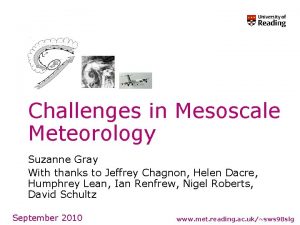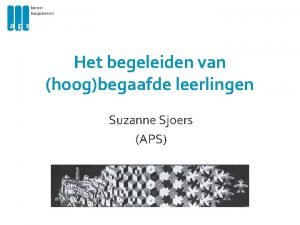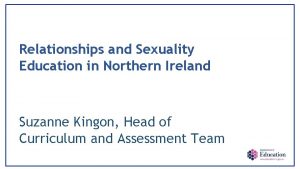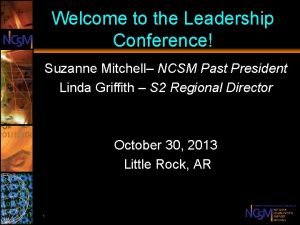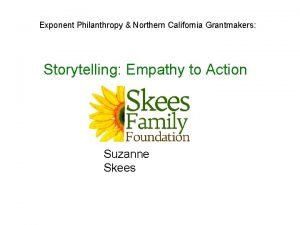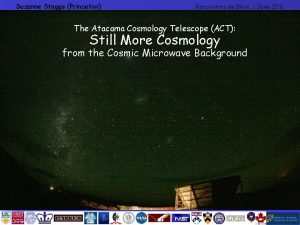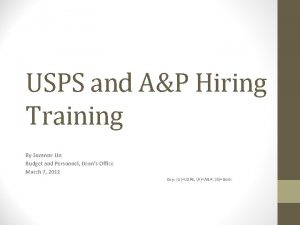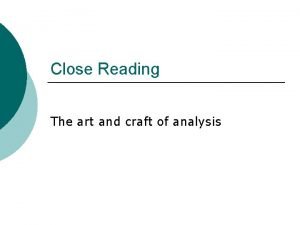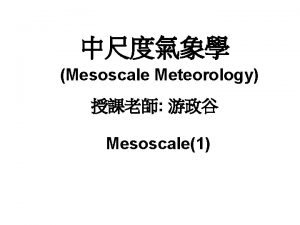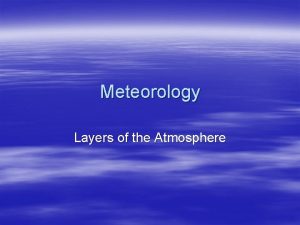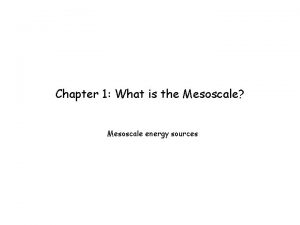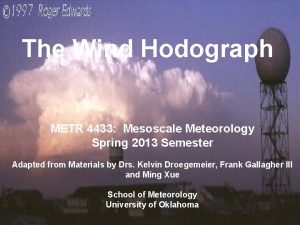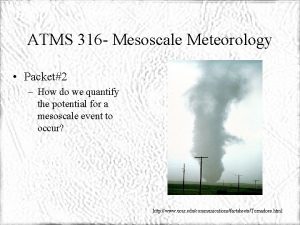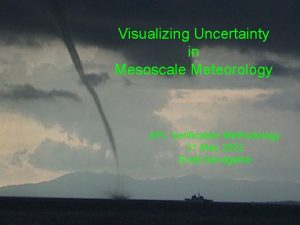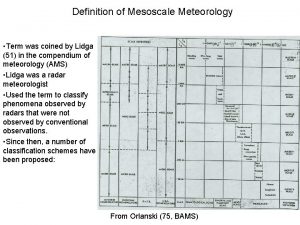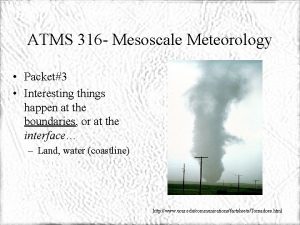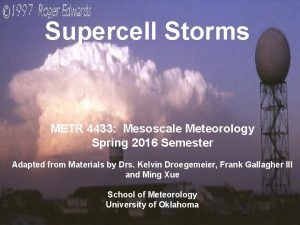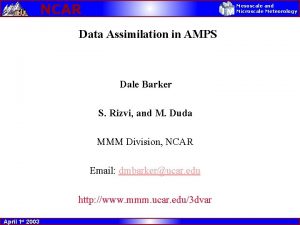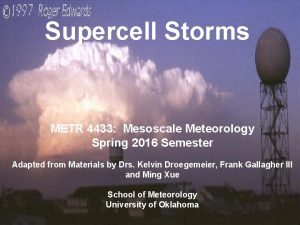Challenges in Mesoscale Meteorology Suzanne Gray With thanks




























- Slides: 28

Challenges in Mesoscale Meteorology Suzanne Gray With thanks to Jeffrey Chagnon, Helen Dacre, Humphrey Lean, Ian Renfrew, Nigel Roberts, David Schultz September 2010 www. met. reading. ac. uk/~sws 98 slg 1

Outline § What is mesoscale meteorology? § Over-riding themes § Specific research areas Ø Convective organisation and banding Ø Mesoscale structures in extratropical cyclones Ø Mesoscale weather systems Ø Stuff that didn’t fit anywhere else. § Conclusions 2

What is mesoscale meteorology? Definition by space- and time-scales Markowski and Richardson: Mesoscale meteorology in midlatitudes 3

What is mesoscale meteorology? A broader perspective § Mesoscale phenomena are strongly influenced by communication with the synoptic- and convective-scales on i t a m infor Mesoscale bridge 4

Outline § What is mesoscale meteorology? § Over-riding themes § Specific research areas Ø Convective organisation and banding Ø Mesoscale structures in extratropical cyclones Ø Mesoscale weather systems Ø Stuff that didn’t fit anywhere else. § Conclusions 5

Over-riding themes Multi-(time and space)-scale prediction § From case studies to climatologies to future predictions: Ø Case studies are usually of interesting or extreme cases, what is typical? Ø How do mesoscale weather features impact climate? Ø How will mesoscale weather features change in the future? § From convective to synoptic scales: Ø What are the benefits of convection-permitting simulations for predicting mesoscale features? Ø What is the upscale impact? Configurations that are both convection-permitting and large-scale accommodating are now practicable. 6

Over-riding themes Predicability and ensembles § Predictability and ensembles: ensembles are being run operationally at resolutions capable of resolving mesoscale features. Ø What is the spread-skill relationship for mesoscale features? Ø What is the impact of stochastic parameterization schemes on the prediction of mesoscale features – in ensembles/deterministic forecasts (upscale transfer of information)? 7

Over-riding themes Diagnostics § What diagnostics/metrics should be used to evaluate `convection-permitting and large-scale accommodating’ experiments? Diabatically generated PV, moist exergetics, entropy production? § Can we design a system of diagnostics to objectively analyse mesoscale flows in weather systems? ? Wokingham supercell storm (Browning and Ludlam, 1962) 8

Outline § What is mesoscale meteorology? § Over-riding themes § Specific research areas Ø Convective organisation and banding v. The large-scale as a constraint v. Banding v. The weak CAPE/strong shear regime Ø Mesoscale structures in extratropical cyclones Ø Mesoscale weather systems Ø Stuff that didn’t fit anywhere else. § Conclusions 9

Convective organisation and banding The large-scale as a constraint CAPE>300 Jkg-1 (thick contour) and CIN>10 Jkg-1 (shaded) (Done et al. , 2007) Water vapour and sferics (Roberts, 2000) 10

Storm-permitting Ensembles x 55 mm © Crown copyright Met Office x 55 mm x 96 mm Nigel Roberts

Convective organisation and banding Challenges • Determination of the scales and environments that have predictability Ø What leads to that predictability? Errors grow faster at smaller scales. Ø When is the finescale detail is controlled by the envelope of mesoscale weather (e. g. , more likely in quasi-equilibrum situations? )? Ø Analogous to the seasonal/decadal predictability problem. • Determination of the scales (and mechanisms) by which the convective scale feeds back to the synoptic scale Ø Over what scales do we need to predict convection correctly to lead to the correct feedbacks (momentum/heat) at the larger-scales? 12

Convective organisation and banding Banding Stacked slantwise circulations in an ana cold front – doppler radar (Browning et al, 2001) Convective snowbands – observed reflectivity (Schumacher et al. , 2010) 13

Convective organisation and banding Challenges • Characterization of the complex interactions between frontogenetically forced circulations, complex terrain, inertial/convective/symmetric instabilities and convectively generated gust fronts. • Prediction of mesoscale banding: can models predict the occurrence and structure of banding in certain circumstances (e. g. when tied to larger-scale features such as fronts – link to DIAMET)? • Determination of the importance of banding for quantitative precipitation forecasting (flooding) • Diagnosis of instabilities – identification of instabilities can be sensitive to methods of diagnosis. 14

Convective organisation and banding Weak CAPE/strong shear regime Mean CAPE for August (Romero et al. , 2007) High resolution (Dx=1 km) Met. UM simulation and structure of one PV dipole (Chagnon and Gray, 2009) 15

Convective organisation and banding Challenges • Determination of the local dynamical consequences of horizontally tilted PV dipoles. Ø How do the circulations associated with the dipoles z interact? • Determination of the larger-scaledynamical consequences of horizontally tilted PV dipoles. Ø Is there a momentum flux on the larger-scale? Ø Is the storm-integrated PV structure correctly represented by convection-parameterizing simulations? Ø Can mesoscale convective systems be properly represented in convection-parameterizing simulations? 16

Outline § What is mesoscale meteorology? § Over-riding themes § Specific research areas Ø Convective organisation and banding Ø Mesoscale structures in extratropical cyclones Ø Mesoscale weather systems Ø Stuff that didn’t fit anywhere else. § Conclusions 17

Mesoscale structures in extratropical cyclones Types of structures I Browning 2005 18

Mesoscale structures in extratropical cyclones Types of structures II Inertia-gravity waves Cloud head top tropopause High level convection Layers of max vertical wind shear Slantwise ascent Upright convection 19

Mesoscale structures in extratropical cyclones 0518 UTC Sting Jets Conceptual picture: Clark et al. , (2005), Browning (2004) 20

Mesoscale structures in extratropical cyclones Challenges • Determination of the predictability of such features in high resolution operational NWP models. Ø Can we predict them? Does it matter? Ø What is their relationship with `extreme weather’: clear air turbulence, quantitative precipitation forecasting (flooding), localised strong surface wind gusts • Determination of their impact on the synoptic scales, e. g. the modification of upper-level trough structure from diabatically (or frictionally? ) generated PV and impact on downstream development. • Determination of their climatological importance and sensitivity to climate change, e. g. how will the frequency of sting jet storms change in the future? 21

Outline § What is mesoscale meteorology? § Over-riding themes § Specific research areas Ø Convective organisation and banding Ø Mesoscale structures in extratropical cyclones Ø Mesoscale weather systems Ø Stuff that didn’t fit anywhere else. § Conclusions 22

Mesoscale weather phenomena Impact of climate change Polar low density distribution (Zahn and von Storch , 2010) 23

Mesoscale weather phenomena Oceanic pathways to impact Turbulent heat fluxes in ERA-40 without and with a parameterized westerly tip jet (Sproson et al. , 2010) Observed cloud vortices and % of these vortices detectable in ERA-40 (Condron et al. , 2008) 24

Mesoscale weather phenomena Challenges • Improving weather forecasts of e. g. polar lows, medicanes, tropical cyclones and the extratropical transition of tropical cyclones Ø Many recent observations/modelling studies of mesoscale arctic features (IPY-THORPEX) and tropical cyclones and their extratropical transitions (T-PARC) Case study based. Ø What benefit do convection-permitting (but large-scale accommodating) simulations provide? • Determining the climate impact of unresolved mesoscale weather features such as polar lows. • Predicting the impacts of climate change on frequency, tracks and intensity. 25

Outline § What is mesoscale meteorology? § Over-riding themes § Specific research areas Ø Convective organisation and banding Ø Mesoscale structures in extratropical cyclones Ø Mesoscale weather systems Ø Stuff that didn’t fit anywhere else. § Conclusions 26

Stuff that didn’t fit anywhere else • Coupling at high resolution: current Met Office work on coupling the high resolution atmospheric model to ocean and hydrological models (e. g. freshwater discharges from rivers affect SSTs in shelf seas which could impact the atmosphere, lake models. . . ). • Dynamics of sea breezes: effects of complex coastlines, near shore islands, synoptic wind directions etc. on sea breeze structure, interaction with cumulus convection. • Organisation of convection by orography. • Effects of cloud-radiation interaction – known to affect MCSs, contributing to their diurnal cycle. 27

Conclusions I’ve emphasized § Upscale impacts and downscale controls on predictability. § The progression from case studies to climatologies and the change in climatologies with climate. § New diagnostic methods for examining mesoscale phenomena. § New forecast methods: ensembles, downscaling. “Understanding the connection between the cloud-scale and the synoptic-scale is a prerequisite to understanding the relationship between weather and climate” (Jeffrey Chagnon) 28
 Mesoscale definition
Mesoscale definition Suzanne gray
Suzanne gray Suzanne sjoers
Suzanne sjoers Suzanne sensabaugh
Suzanne sensabaugh Suzanne knop
Suzanne knop Suzanne wayne
Suzanne wayne Suzanne kapelari
Suzanne kapelari Suzanne menezes
Suzanne menezes Suzanne kingon
Suzanne kingon Suzanne hilton
Suzanne hilton Language
Language Dr suzanne mitchell
Dr suzanne mitchell Beistrichsetzung
Beistrichsetzung Litosfr
Litosfr Dr suzanne smith
Dr suzanne smith Suzanne adair penn state
Suzanne adair penn state Suzanne van wijk
Suzanne van wijk Northern california grantmakers jobs
Northern california grantmakers jobs Suzanne bakken
Suzanne bakken Suzanne van der velde gescheiden
Suzanne van der velde gescheiden Author of hunger games
Author of hunger games Suzanne merlis
Suzanne merlis Suzanne meade
Suzanne meade Suzanne donaldson
Suzanne donaldson Suzanne briet
Suzanne briet Suzanne staggs
Suzanne staggs Suzanne bierman nevada
Suzanne bierman nevada Suzanne lin
Suzanne lin Ground zero suzanne berne
Ground zero suzanne berne

